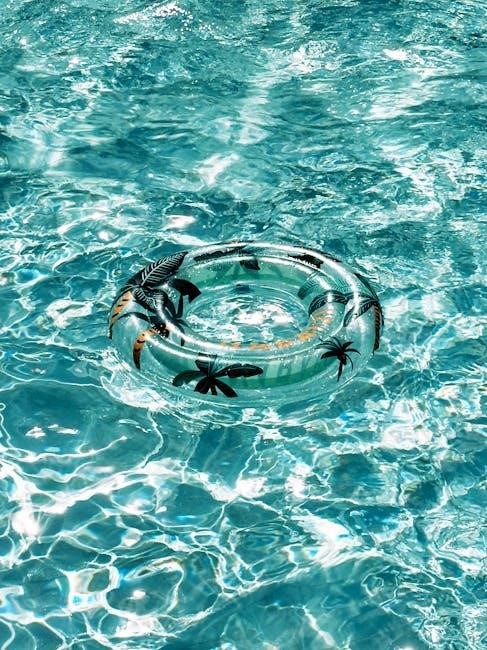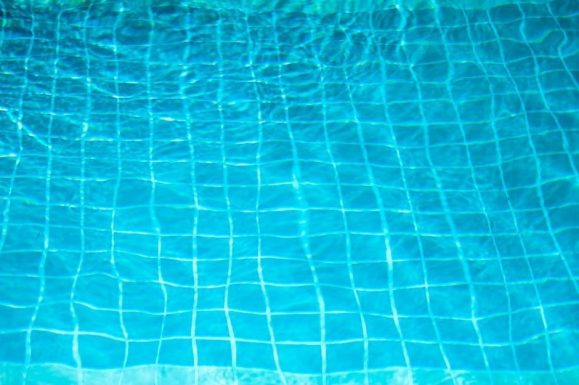Maintaining a salt water pool requires a balance of effort and reward, ensuring clean, safe water while preserving equipment longevity. Regular tasks include testing water chemistry, monitoring salt levels, and cleaning equipment to prevent issues like algae growth or corrosion. Proper maintenance ensures optimal performance and extends the life of your salt water pool system.
Why Proper Maintenance is Essential
Proper maintenance is crucial for ensuring the safety, efficiency, and longevity of your saltwater pool. Regular upkeep prevents contamination, protects equipment, and avoids costly repairs. Neglecting tasks like water testing and cleaning can lead to imbalanced chemistry, algae growth, and corrosion. Maintaining optimal salt levels and pH ensures the chlorine generator functions correctly, keeping water sanitized and swimmers safe. Consistent care also prevents mineral buildup and erosion, extending the life of your pool and its components. Proper maintenance ensures a clean, healthy, and enjoyable swimming environment while safeguarding your investment.

Key Components of a Salt Water Pool System
A salt water pool system includes a saltwater chlorine generator, pump, filtration system, salt cell, and skimmer. These components work together to sanitize and circulate water efficiently.
The Saltwater Chlorine Generator
The saltwater chlorine generator is the heart of a saltwater pool system, converting salt into chlorine to sanitize the water. This process eliminates the need for manual chlorine addition, reducing harsh chemicals and minimizing eye irritation. The generator works by electrolysis, breaking down salt into chlorine gas, which dissolves in the water to kill bacteria and contaminants. Regular maintenance, such as cleaning the cell and monitoring salt levels, ensures optimal performance and extends the lifespan of the generator. Proper function is crucial for clean, safe, and enjoyable swimming conditions.
The Role of the Pump and Filtration System
The pump and filtration system are essential for maintaining clean and clear water in a saltwater pool. The pump circulates water through the filter, removing debris and contaminants, while the filter traps impurities to ensure clean water. Proper flow rates and consistent operation are critical for effective filtration. Regular maintenance, such as cleaning the filter and checking for blockages, ensures the system runs efficiently. A well-functioning pump and filtration system not only keep the water clean but also support the chlorine generator’s ability to sanitize the pool effectively, ensuring a safe and enjoyable swimming environment.
Understanding the Salt Cell
The salt cell is the heart of a saltwater pool system, converting salt into chlorine to sanitize the water. This process eliminates the need for manual chlorine addition, reducing harsh chemical effects. The cell uses electrolysis to produce chlorine, ensuring consistent sanitation and gentler water for swimmers. Proper salt levels and regular cleaning are essential for optimal performance. Over time, the cell may degrade, requiring replacement to maintain efficiency. Understanding its function and maintenance needs is crucial for keeping your saltwater pool clean, safe, and enjoyable year-round.
Importance of the Skimmer and Drainage System
The skimmer and drainage system play a vital role in maintaining clean and clear water in your saltwater pool. The skimmer removes floating debris, such as leaves and dirt, from the water’s surface, preventing it from sinking and causing contamination. Proper drainage ensures even water circulation, which is essential for balanced chemical distribution and effective sanitation. A well-functioning skimmer and drainage system also help prevent algae growth by removing organic matter that algae feed on. Regular cleaning of these components is crucial to maintain optimal water quality and protect your pool equipment from damage caused by debris buildup.

Essential Salt Water Pool Maintenance Tasks
Regular maintenance ensures optimal performance and longevity. Monitor water chemistry, clean equipment, and check salt levels to maintain clarity, safety, and proper circulation in your saltwater pool.
Daily Maintenance Checklist
A daily routine ensures your saltwater pool stays clean and safe. Test pH levels, ensuring they remain between 7.2 and 7.8. Check salt levels, maintaining 2700-3400 ppm. Skim the surface and clean the pool floor to remove debris. Ensure proper water circulation by running the pump for 8-12 hours. Inspect the filter and backwash if necessary. Monitor chlorine levels, adjusting as needed. Finally, check the salt cell for proper function and clean it if required. These tasks ensure optimal water quality and equipment performance, keeping your pool refreshing and safe for use.
Weekly Maintenance Routine
Your weekly routine is crucial for maintaining a healthy saltwater pool. Start by testing and adjusting alkalinity and stabilizer levels to prevent fluctuations. Shock the pool to eliminate contaminants and oxidize organic matter. Inspect and clean the salt cell to ensure chlorine production. Backwash the filter thoroughly and check for any signs of wear. Monitor the skimmer and pump baskets, emptying them as needed. Additionally, perform a visual inspection of the pool and surrounding areas to remove any debris. These weekly tasks help maintain water clarity, balance, and equipment efficiency, ensuring your pool remains safe and enjoyable year-round.
Monthly Maintenance Requirements
Monthly maintenance is essential to ensure your saltwater pool remains in optimal condition. Start by performing a deep clean of the filter, including disassembling and soaking it in a cleaning solution. Inspect the salt cell for calcium buildup and clean it if necessary. Check the pool’s equipment for any signs of corrosion or wear. Test the water for calcium hardness and adjust as needed to prevent scaling. Finally, perform a comprehensive water test, including salt levels, pH, alkalinity, and stabilizer, and make adjustments to maintain balance. These monthly tasks help prevent long-term issues and keep your pool running smoothly.
Seasonal Maintenance Tips
Seasonal maintenance is crucial to prepare your saltwater pool for varying conditions. At the start of the season, balance the water chemistry, clean the filter, and inspect the salt cell for damage. During peak use, monitor salt levels and perform mid-season cleaning of the cell. At the end of the season, lower the water level, drain excess water, and winterize the equipment to prevent damage; Regularly check for calcium buildup and erosion, especially in warm climates. By following these seasonal tips, you can ensure your pool remains efficient and safe year-round, extending the lifespan of your saltwater system.

Water Chemistry and Balance
Balancing water chemistry is vital for a saltwater pool. Monitor pH levels, salt concentration, alkalinity, and stabilizer to ensure swimmer comfort and prevent equipment corrosion or damage.
How to Test and Balance pH Levels
Testing and balancing pH levels is crucial for maintaining a saltwater pool. Use a liquid testing kit or strips for accuracy, aiming for a pH range of 7.2–7.8. Imbalanced pH can cause eye irritation, damage equipment, or reduce chlorine efficiency. To adjust, add muriatic acid to lower pH or soda ash to raise it. Always follow manufacturer instructions and test water after adjustments. Regular testing, ideally twice a week, ensures optimal conditions for swimmers and equipment. Proper pH balance prevents corrosion and keeps the pool safe and enjoyable year-round.
Maintaining Optimal Salt Levels
Maintaining optimal salt levels is essential for your saltwater pool’s efficiency. The recommended salt concentration is typically between 2,700 and 3,400 ppm, with an ideal level around 3,200 ppm. Salt levels should be checked monthly using a salt test kit or digital meter. Adjustments are usually needed after heavy rain, frequent use, or draining water. Adding salt when levels are low ensures the chlorine generator functions properly, maintaining clean and sanitized water. Proper salt levels prevent erosion and corrosion of equipment, ensuring optimal pool performance and swimmer comfort throughout the season.
Understanding Alkalinity and Stabilizer
Alkalinity and stabilizer are crucial for maintaining water balance in your saltwater pool. Alkalinity measures the water’s ability to resist pH changes, with a recommended range of 80-120 ppm. Stabilizer, or cyanuric acid, protects chlorine from sunlight degradation, ensuring effective sanitation. Proper levels prevent fluctuations in pH, which can damage equipment or cause eye irritation. Test alkalinity and stabilizer weekly, adjusting as needed to maintain stability. Balanced levels ensure smooth operation of the saltwater chlorine generator and overall water quality, making your pool safe and enjoyable for swimmers.
Preventing Calcium Buildup
Preventing calcium buildup is essential for maintaining your saltwater pool’s health. High calcium levels can cause scaling on surfaces and equipment, reducing efficiency. Regularly test calcium hardness, aiming for 200-400 ppm. If levels are too high, drain and refill with fresh water. Use a stabilizer to prevent calcium from binding with other minerals. Clean the salt cell and filter regularly to avoid mineral deposits. Addressing calcium buildup promptly ensures your pool remains clear, equipment lasts longer, and swimmer comfort is maintained. Regular maintenance prevents costly repairs and keeps your pool system running smoothly. Monitor and balance calcium levels to avoid scaling issues.
Sanitation in Salt Water Pools
Salt water pools use a chlorine generator to sanitize water, producing gentler chlorine than traditional systems. This method reduces chloramines, minimizing eye irritation and unpleasant odors, ensuring cleaner water.
The Role of the Salt Cell in Sanitation
The salt cell is the heart of your pool’s sanitation system, converting salt into chlorine to disinfect the water. It produces chlorine naturally, eliminating the need for manual addition, and burns off harmful chloramines during generation. This process keeps the water clean and reduces eye irritation. Regular maintenance, including cleaning the cell and monitoring salt levels, ensures optimal performance and extends its lifespan. A well-functioning salt cell is essential for maintaining clear, safe, and enjoyable pool water throughout the season.
When and How to Shock the Pool
Shocking your salt water pool is essential to remove contaminants like chloramines and organic matter that the salt cell can’t eliminate. It’s recommended to shock the pool weekly, or after heavy use or storms, to maintain clean and safe water. Use a shock treatment specifically designed for salt water systems to avoid damaging the salt cell. Always follow the product instructions for proper dosage and application. Shocking at night helps prevent UV rays from breaking down the oxidizers before they can work effectively. Regular shocking ensures optimal water clarity and swimmer comfort throughout the season.
Caring for Your Salt Water Pool Equipment
Regular cleaning of the filter, proper pump function, and salt cell maintenance are vital to prevent issues and ensure smooth operation of your salt water pool equipment.
Regular Cleaning of the Filter
Regular cleaning of the filter is essential to ensure optimal water circulation and sanitation in your salt water pool. A dirty filter can reduce system efficiency, increase chlorine demand, and lead to poor water quality. Depending on usage, clean the filter cartridge or grid at least once a week by rinsing with a garden hose or soaking in a chemical cleaner. Backwashing sand or DE filters monthly is also crucial. Proper filter maintenance prevents debris buildup, ensuring clear water and extending equipment lifespan. Consistent cleaning helps maintain the balance of your salt water pool system. Always follow manufacturer guidelines for best results.
Maintaining the Salt Cell
The salt cell is a critical component of your salt water pool system, responsible for converting salt into chlorine to sanitize the water. Regular maintenance ensures its efficiency and longevity. Inspect the cell for calcium buildup, which can reduce performance. Clean the cell every 3-6 months by soaking it in a mixture of water and acid, following the manufacturer’s instructions. Replace the cell when it shows signs of wear or corrosion. Regular inspections and prompt cleaning prevent damage and ensure consistent chlorine production, keeping your pool water clean and safe for swimming.
Ensuring Proper Pump Function
The pump is the heart of your salt water pool system, ensuring proper water circulation and filtration. To maintain optimal function, check daily for unusual noises or leaks. Ensure the pump is primed correctly to avoid damage. Clean the pump basket regularly to prevent debris buildup, which can restrict flow. Monitor the pressure gauge for abnormal readings, as this may indicate blockages or worn parts. Inspect and replace worn or damaged seals to maintain efficiency. Finally, schedule professional servicing every 6 months to ensure longevity and peak performance of your pump.
Common Issues and Solutions
Common issues in salt water pools include algae growth, corrosion, and calcium buildup. Regular testing, cleaning, and balancing chemicals can prevent these problems and ensure optimal pool conditions.
How to Prevent Algae Growth
Preventing algae growth in a salt water pool requires consistent maintenance. Regularly test and balance pH levels between 7.2 and 7.8, and maintain proper salt levels around 2700-3400 ppm. Ensure adequate circulation and filtration by running the pump for sufficient time daily. Shock the pool weekly to eliminate organic matter and consider using an algaecide as a preventative measure. Clean the pool and filter regularly to remove debris, and monitor for early signs of algae, such as cloudy water or greenish tint, to address them promptly before they escalate.
Addressing Erosion and Corrosion
Preventing erosion and corrosion in a salt water pool is crucial to protect equipment and surfaces. Regularly inspect pool components, such as the salt cell, pump, and pipes, for signs of wear or rust. Ensure proper water circulation to avoid stagnation, which can accelerate corrosion. Maintain balanced salt levels (2700-3400 ppm) and pH levels (7.2-7.8) to minimize corrosive effects. Use corrosion-resistant materials for equipment and consider applying protective coatings. Address any signs of erosion or corrosion promptly to prevent costly damage. Regular maintenance and inspections are key to extending the lifespan of your salt water pool system.
Recommended Maintenance Schedule
Daily checks include monitoring pH and salt levels, while weekly tasks involve testing water chemistry and cleaning equipment. Monthly, inspect and clean the salt cell and filter.
Daily and Weekly Checks
Regular inspections are crucial for maintaining a saltwater pool. Daily, check the salt levels, pH, and ensure proper water circulation. Skim debris and monitor the filter’s performance. Weekly, test stabilizer and alkalinity levels, clean the salt cell, and inspect the pump and filtration system. These routine checks prevent issues like algae growth or equipment damage. Consistency ensures your pool remains safe, clear, and enjoyable all season. Neglecting these tasks can lead to costly repairs and poor water quality. Staying proactive keeps your pool in optimal condition.
Monthly and Seasonal Tasks
Monthly, check and clean the filter, inspect the salt cell for buildup, and test stabilizer and alkalinity levels. After heavy rain or water loss, test salt levels and adjust as needed. Seasonally, deep clean the pool, drain and refill if necessary, and rebalance water chemistry. In warmer climates or with frequent use, service the pool every six months. Regular seasonal maintenance prevents corrosion, ensures optimal performance, and extends equipment life. These tasks are essential for maintaining water quality and system efficiency throughout the year.

Additional Tips for Optimal Maintenance
Invest in a high-quality saltwater test kit for accurate readings. Clean the salt cell regularly to prevent mineral buildup. Monitor water circulation to ensure proper filtration and chemical distribution. Keep the skimmer and pump baskets clear to maintain efficient water flow. Regularly inspect pool equipment for signs of wear or corrosion. Maintain consistent water levels to prevent equipment strain. These practices will help ensure your saltwater pool remains clean, safe, and well-maintained year-round.
Using the Right Testing Tools
Accurate testing is crucial for maintaining your saltwater pool. Use a high-quality liquid testing kit for precise measurements of pH, salt levels, alkalinity, and stabilizer. While testing strips are convenient, they may lack the accuracy needed for optimal water balance. Digital testers are also available for advanced users, offering quick and reliable results. Regularly test your pool water to ensure all parameters are within the recommended range. Proper testing tools help prevent imbalances that can lead to equipment damage or unsanitary conditions. Invest in a reliable kit to keep your pool water safe and crystal clear.
Keeping a Maintenance Record
Maintaining a detailed record of your saltwater pool’s upkeep is essential for tracking water chemistry, equipment performance, and cleaning schedules. Use a notebook, spreadsheet, or pool maintenance app to log pH levels, salt concentrations, and cleaning tasks. Note any adjustments made, such as adding salt or balancing alkalinity. Regularly reviewing your records helps identify trends and potential issues before they escalate. A well-kept record ensures consistency, prevents oversights, and extends the lifespan of your pool and its equipment, making it easier to enjoy a safe and inviting swimming environment year-round.
Proper salt water pool maintenance ensures a safe, clean, and enjoyable swimming experience while extending the life of your equipment. By following a consistent routine, monitoring water chemistry, and performing regular cleaning tasks, you can prevent issues like algae growth or corrosion. While maintaining a saltwater pool requires effort, the benefits of reduced chlorine use and gentler water make it worthwhile. Keep detailed records to track your progress and address potential problems early. With dedication and the right practices, your saltwater pool will remain a refreshing and inviting space for years to come.
